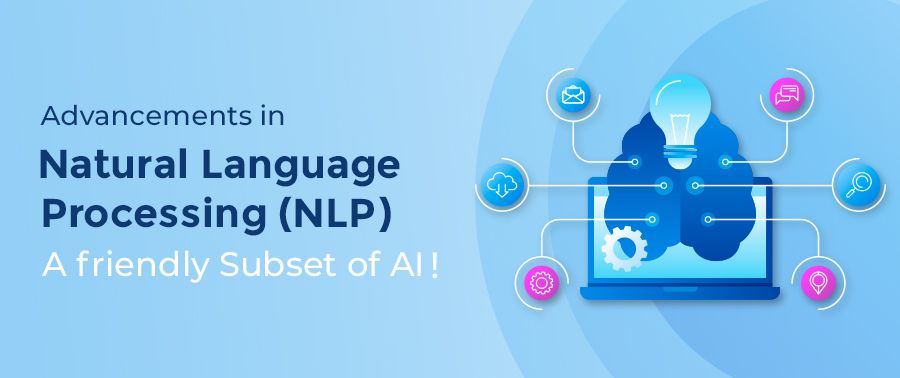The capacity to comprehend natural spoken language in the technological field has become a more prioritized factor. With the advancement of AI bots like Siri, Cortona, Alexa, and Google Assistant, the need for ALPI manifolds rapidly.
NLP- Natural Language Processing is a subset of AI, which assists computers to read, interpret and act intelligently on human commands and languages. It is a vast field of methods and algorithms which benefits language translation, sentiment analysis, and interaction with chatbots. It is evolving as the best assistance to humans.
The advancements of NLP have benefited almost every industry, such as healthcare, customer service, education, and research.
Today, let's examine the basis of NPL and acknowledge the modern trends in detail to curate better knowledge.
Historical Overview of NLP
Beginning of NLP with Limitations
The roots of NLP can be traced back to the 1950s when researchers first began exploring the possibilities of automating language, understanding, and translation.
In the early days of NLP, systems primarily relied on rule-based approaches, which required hand-crafted linguistic rules. It has always been difficult for linguistic rule-based methods to handle syntax, context, and semantics. These systems struggled for nuances and variations in human language, making it challenging to achieve accurate results. The lack of comprehensive language resources and the absence of large-scale annotated datasets further hindered progress.
Evolution of NLP Technologies
Later in the 1990s, more precise language processing began to rule the statistical technologies. It is when improved linguistic comprehension was made possible by the researchers. Also, the use of massive text corpora, the advent of machine learning, and the availability of large amounts of text data helped NLP witness significant advancements. Statistical methods like Deep Learning and Machine Learning became popular. It allows systems to learn patterns from data and make predictions. Hidden Markov Models (HMMs) and n-gram models were used for speech recognition and language modeling. These advancements revolutionized NLP Technologies and brought out new scopes.
The Modern Approach of NLP
What is NLP?
Natural Language Processing, or NLP, is the study of utilizing computers to analyze and comprehend human text and speech. It encompasses a range of tasks such as translating between languages, speech recognition, text analysis, and automatic text generation. Also, other tasks like classification, named entity recognition, sentiment analysis, machine translation, question-answering systems, and more are performed by NLP. NLP systems aim to bridge the gap between human language and computational algorithms, enabling effective communication and interaction between humans and machines.
To define NLP-
Natural Language- The language naturally developed by humans.
Natural Language Processing- The capacity of computers to deal with human language to read, write, understand, decipher, make sense, and more.
NPL deals with two types of data- written and spoken data. The raw text is unusable in NPL technology, so it is better to convert the RAW data into written data.
How NLP works
When it comes to processing NPL Technologies, different techniques are used in this process-
Lemmatization- It is a form where a word is converted into a single form with a mode of grouping inflections.
Word Segmentation- It entitles the separation of large pieces of text into units.
Parsing- It is the process of analyzing the grammatical errors of a sentence.
Word Sense Disambiguation- It includes the identification of meaning present in a whole context through word analysis.
The Importance of NLP
NLP has become increasingly important in various domains due to its ability to automate language-related tasks, derive insights from textual data, and enhance human-computer interaction. It allowed robots or computers to process more human-like interactions with people. It enables businesses to analyze customer feedback, automate customer support, extract valuable information from unstructured data, improve search engines, and develop intelligent virtual assistants.
Core Components in NLP
Text Processing-
This includes Tokenization, stemming, normalization, and more. While stemming and normalization restore words to their conventional root forms, tokenization involves separating a string of text into its words or tokens.
Syntax and Grammatical Analysis-
NPL uses syntax and grammatical analysis for language understanding, rectifying the grammatical structure of a sentence, and recognition of subject & verb agreements, and noun phrases.
NER & Parts-of-Speech Tagging-
As the name suggests Named Entity Recognition (NER) analyses text for the presence of named entities. On the other hand, Part-of-Speech (POS) tagging annotates words with grammatical labels. This clarifies syntactic responsibilities and interrelationships of words in a given phrase.
Sentiment and Motion Detection-
NPL systems understand sentiment by examining the emotional tone of written information. It determines whether the sentence is good, negative, or neutral. Going a step further, emotion recognition finds out certain emotions conveyed in a text, including joy, fury, or grief.
Top 12 Language Model Advances in the Field of NLP
Now that you are quite familiar with NLP, let's acknowledge the trends and advances in the field. The purpose of this is to familiarize you with NLP and demonstrate what this amazing technology is capable of.
ULMFit
The ULMFit stands for Universal Language Model Fit Tune also called transfer learning in the field of NLP. it is a language model created in 2018 by fast.ai to support transfer learning to the NLP community. This entails multiple task performance and fine-tuned specific tasks, reducing the need for extensive task-specific training data.
BERT
This invention, which was also developed by Google AI teams in November 2018, applies the theory of both the previously described developments to the bidirectional training of transformers. It is a cutting-edge model that can handle 11 NLP tasks. It has been pre-trained using the over 2.5 billion words in the whole English Wikipedia dataset.
Google's Transformer-XL
In terms of language modeling, this model from Google AI (January 2019) performed better than BERT. Additionally, it fixed the context fragmentation problem that the first transformers had.
Standford NLP
Python's Stanford NLP library performs natural language processing. It includes tools for breaking down a string of human language text into lists of phrases and words, generating the parts of speech and morphological characteristics of those words, and providing a syntactic structure dependency parse. It expands the application of NLP beyond the confines of English to encompass pre-trained neural models for at least 53 human languages.
Open AI, GPT-2
GPT-2 stands for "Generative Pre-trained Transformer 2". It was developed by OpenAI in the year 2019. The main goal of the advanced model is to employ tasks related to the NLP component of natural language generation. This text-generating model represents SOTA (state-of-the-art) technology. GPT-2 can produce an entire article from a few short input sentences.
XLNet
XLNet by CMU AI was developed in June 2019. It takes advantage of TransformerXL's and BERT's top qualities and makes language modeling more convenient.
PyTorch- Transformers
Hugging Face's team performed a miracle in July 2019 when they produced PyTorch Transformers. This tool allows you to perform tasks using TransformerXL, XLNET, and BERT models with just a few lines of Python code.
ERNIE
ERNIE stands for Enhanced Representation through kNowledge IntEgration. It was built by Baidu in July 2019. Being a pre-trained language understanding model, it achieved state-of-the-art results and outperformed BERT and XLNet in 16 NLP tasks in both Chinese and English.
RoBERTa
RoBERTa is a Robustly Optimized BERT pre-training approach developed in July 2019. To optimize the BERT training process, Facebook AI developed this model crossing the parameters.
spaCY-PY Torch Transformers
In August 2019, spaCY-PY Torch Transformers was released for language processing. PyTorch and spaCy are both employed in the construction of the Transformers, which enables the deployment of transformers.
Facebook AI XLM/mBERT
Facebook introduced this multilingual language model with around 100 languages in August 2019. It is SOTA for machine translation and cross-lingual classification.
Stanza
An upgraded version of the Stanford NLP was launched in April 2020, which covers 66 different languages. Tokenization, multi-word token expansion, lemmatization, part-of-speech and morphological feature tagging, dependency parsing, and named entity recognition are all part of Stanza's language-independent, fully neural text analysis pipeline.
Language Model Implications in NLP
Text Generation and Completion-
Language Models opened up the possibilities for text creation and completion which are quite encouraging. Language models can generate content that is logical and contextually suitable, even from the wrong commands. It best suits situations like code completion and automatic content production.
Question Answering and Chatbot-
The language models have increased the efficacy of chatbots and question-answering robots. They assess the context of a question to give acceptable answers. Chatbots that use language models in their conversations appear more human.
Machine Translation and Summarization-
The language models have substantially enhanced machine translation. Using pre-trained models and then adjusting them for certain translation workloads can improve the quality of translations. The summarization of content and information extraction is two other tasks for which language models are helpful.
Future Perspective of NLP
The future of NLP holds great promise, with ongoing research focusing on pushing the boundaries of language understanding and generation. Further advancements are expected in areas such as multi-modal understanding, reinforcement learning for language tasks, more efficient training techniques, and better incorporation of world knowledge into NLP systems.
Conclusion
Natural Language Processing and AI have made remarkable strides in recent years, transforming the way machines understand and interact with human language. The continuous advancement in NLP opens up new domains and language processes conveniently. Also, it has the potential to change the future perspectives of businesses enhancing human-machine communication. It is the future for determining the direction of AI and creating new opportunities for intelligent systems across a variety of fields.






Top comments (0)